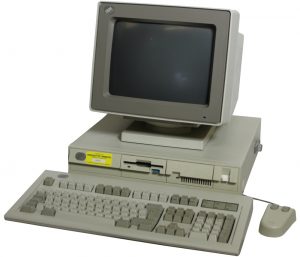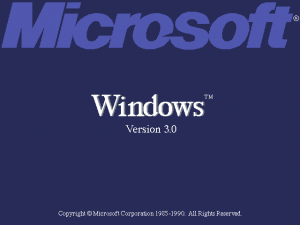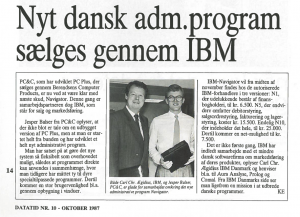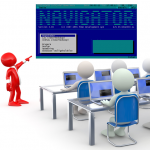Cooperating with IBM – for Better or Worse
Everyone in the market was taken by surprise when, in October 1987, PC&C announced that IBM should be in charge of distributing their new product Navigator (PC&C changed its name to Navision Software in 1995).
In 1987, PC&C was a small Danish software house with just 7 employees and a turnover of less than one million dollars (1986/87). IBM was a multinational giant with more than 400,000 employees and a turnover of over USD 250 billion. IBM’s Danish subsidiary was the top performing role model in the group and had a market share in the Danish PC market, well above any other country where it operated.
PC&C’s revenue rose to USD 2.1 million in the fiscal year 1987/88, dropped to USD 1.8 million in 1988/89, then rose steadily to USD 13.1 million in 1994/95 when the cooperation stopped – essentially terminated by IBM!
PC&C and IBM were the perfect match
 In 1987, an alliance between PC&C and IBM was a perfect match. PC&C had developed a new multi-user system to replace PCPLUS, and they were not satisfied with their distributor Sophus Berendsen Computer Products. In fact, IBM had made a great deal of effort to get a PCPLUS distribution agreement, but it was not possible to find a solution with two distributors.
In 1987, an alliance between PC&C and IBM was a perfect match. PC&C had developed a new multi-user system to replace PCPLUS, and they were not satisfied with their distributor Sophus Berendsen Computer Products. In fact, IBM had made a great deal of effort to get a PCPLUS distribution agreement, but it was not possible to find a solution with two distributors.
1987 was also the year in which IBM, with the launch of the PS/2 systems, tried to gain more control over the PC market. In addition, IBM needed a financial management software package to strengthen its position vis-à-vis SMEs (small and medium-sized enterprises), where the company was not so strong, but where the growth of PC sales was concentrated. In other words, Navigator, as the new PC&C system was called, would help IBM Denmark to expand its position in the fastest growing segment of the PC market.
As I describe in my book, 5,460 Miles from Silicon Valley, PC&C and IBM Denmark were a perfect match in 1987. There was a significant overlap in their interests and the chemistry between the two companies was excellent. A project aimed at porting Navigator to IBM’s AS/400 minicomputers contributed further to the expectations of the partnership.
The alliance with IBM contributed substantially to their self-perception and ignited global ambitions within the small three-year-old company. If the collaboration with IBM in Denmark could be made successful, what would prevent it from being repeated with all IBM’s subsidiaries worldwide?
The other side of the coin
At its highest IBM enjoyed a 35% share of all PC sales in Denmark. But IBM only allowed their own resellers to sell Navigator, while other resellers could sell IBM PCs to customers who chose Concorde from competitor Damgaard Data. Although the partnership with IBM Denmark gave PC&C a “blue stamp” and boosted growth, they would never be able to surpass Damgaard Data, which had unrestricted access to both the remaining 65% of the market that IBM did not reach and that part of IBM’s 35% who did not want Navigator. Choosing a hardware supplier as the exclusive distributor of Navigator turned out to have its inherent limitations. No one thought of that as they sipped the champagne to celebrate the unusual engagement.
The battle of the operating systems
 When the collaboration between IBM and Microsoft, on the development of OS/2, ceased in 1992, and IBM carried on on their own, a natural conflict of interests was introduced into the partnership with PC&C.
When the collaboration between IBM and Microsoft, on the development of OS/2, ceased in 1992, and IBM carried on on their own, a natural conflict of interests was introduced into the partnership with PC&C.
During a visit to Comdex in the United States in April 1991, the delegation from PC&C had learned that OS/2 did not enjoy much support from other software developers. On the contrary, everyone had put their bets on Windows 3.1. When OS/2 achieved a certain success in Denmark, it was entirely due to IBM’s very strong position with the very big companies that had the tradition of following the recommendations made by their IT providers.
This group of customers was outside PC&C’s core market.
Since IBM invested significant funds in the development and marketing of OS/2 after 1992, it led to increasing friction in the relationship with PC&C. PC&C did not believe IBM would break Microsoft’s success in the lower part of the market.
PC&C had different plans and they did not comply with IBM’s strategy.
This series of posts continues.
See also:
More about the book: “5,460 Miles from Silicon Valley”
An Idea That Eventually Turned Out to Be Worth $1.3B
Why Is the “5,460 Miles from Silicon Valley” Story Still Relevant Today?









